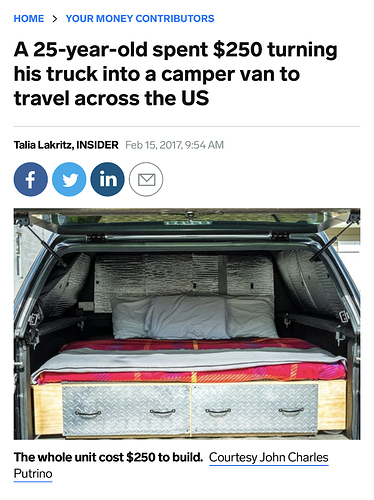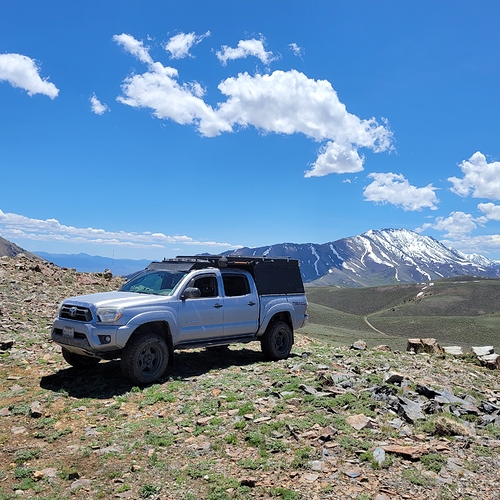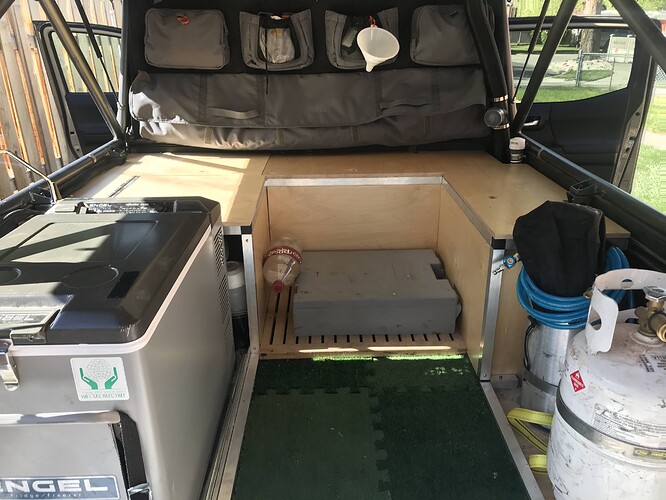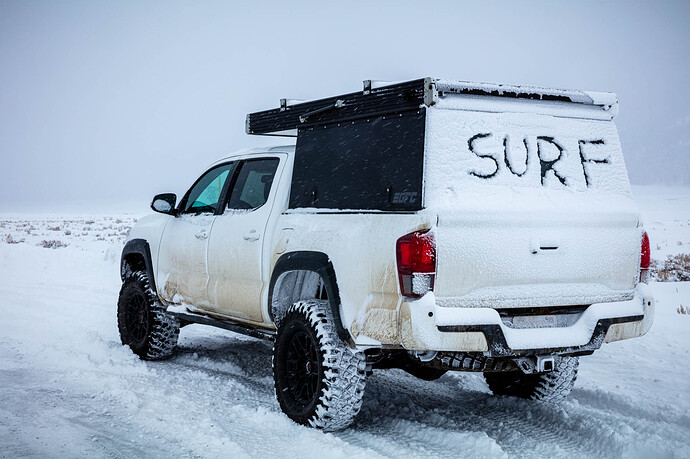Heres some notes from my experience winter camping. I was in Yellowstone for wildlife photography and was up at 5am driving into the national park, staying all day and driving out after dark to USFS road to camp. Living in a 5ft bed is no walk in the park and being prepared for anything, staying well organized and having all you need to be comfortable without overpacking is the difference that can make months on the road enjoyable. Being on the road can get rough, especially getting past the first week if its a long term trip and especially in winter. If your not organized, self sufficient, comfortable and well prepared then its really easy to call a trip short and just go home. Hopefully some of my tips / experiences below can get the ideas rolling and help out a little bit.
Battery / Charging: I have a goalzero in my truckbed and was driving a lot every day looking for wildlife. This kept my battery charged by night time and I also have two 100w solar panels on the roof. I didnt get much charge in Yellowstone but when i’m somewhere more remote and staying in one place for days on end the solar is essential. Batteries dont like the cold and goalzero lithium batteries specifically will not take in a charge if you let the battery get below 32deg. If it gets around -5 or -10 it wont let out a charge either. I started keeping the battery in the cab because it warms up faster in there with the charging cord to a 12v (which I normally had wired up in the bed) and every night I brought it back into the bed where I watched movies, used the lights, charged cameras. This twice a day battery shift became really annoying so I started keeping my campers battery in my yeti cooler and wired the solar and 12v into it with other things I didnt want frozen like eggs, fruit, a days worth of water, canned food, etc. To keep things in the cooler from freezing I boiled water and put it in there in a Nalgene water bottle. I got tired of the wires coming out of my cooler not being able to move it and eventually got a soft sided cooler the size of my battery with a easy access lid, mounted it up full time somewhere convenient and wired my cords into it. When it got cold too cold to take in a charge I used the hot water nalgene trick or ran my new diesel heater towards it (I got the heater on the tail end of the trip). Keep in mind the diesel heater takes a fair bit of electricity to run. If I didnt get my battery charged one night for whatever reason and wanted to run my heater or needed electricity for cameras I have some hanging AAA powered led’s and headlamps instead of the camper lights.
Warmth in the cold: I have both a -20 deg bag and a 15 deg bag as well as a nice jacket. In extreme colds I found wearing two sets of 250 merino base layers (long sleeve & long johns) works incredibly well. Dont kill yourself with a mr buddy or similar propane heater. Additionally my best friend has sewn together a thermal kit for his gfc. The idea behind it is a thick layer of fabric for a second tent wall that velcros in. He has yet to take it into winter but I bet it does really well. I also want to note that I dont have a fan and condensation has only ever been an issue a couple of nights out over a year of use. If your worried about that you can have a towel, keep a window open, or run a diesel heater.
About the diesel heater: A heater is a luxury and wont always be reliable (fuel, battery, cheap components.) Have nice equipment before you rely on a heater. If you do have one use with extreme caution. I have 2 carbon monoxide detectors and leave the little windows open for ventilation, even if the exhaust is well routed and even if it does seem too cold to do so. You don’t know if your in trouble because you cant smell it… I do sleep with it on if its around -20 outside.
A note about fuel: Take it from me, I spilt diesel in my truck bed every now and then trying to refuel my heater and kept both gasoline and diesel in the bed with me. Avoid fuel in your truck bed if your living in there at all costs. Its also simply dangerous. I cook and live in the bed and spills just suck. Nowadays I keep my fuel on the roof rack on the cab - thought about having it on a bumper swingout but my spare tire fits just fine under the bed, dont want to swing it open everytime I get in and I wouldnt want someone rear ending gas cans on my bumper.
GFC side panel and tent latches: These can freeze shut and its happened to me 3 times. Its only going to happen if there is a freeze when everything is still wet. You can lube all your locks and latches every couple months which will help with them freezing. If they do freeze run boiling water over them.
Water: I like my water in the cab in the winter as it thaws after a bit of driving around with the heater on. 1 gallon containers fit well behind the tacoma back seats and I have several back there. I have a 5 gallon water jug in the bed and in the summer I have 2-3 (thats including the gallon jugs in the cab). I use a lot less water in winter and more wetwipes (which freeze too) and paper towels or melt snow to do dishes.
Winter recovery: Roads close and shit happens. Be prepared to be stuck somewhere! Have enough of everything to survive for a few days in an emergency. This means sleeping bags, food, water, propane, gasoline, diesel, solar panels, etc. I also carry a garmin InReach for emergency communication anywhere. An emergency can be as simple as you getting snowed in on a trail or slipping off the road in a remote place. In winter I take it really slow after a couple of really close calls. When you do have a close call remember to pump the breaks and don’t overcompensate turning the wheel. I’m also in 4x4 full time if there is ice/snow on the road. This has saved me once when simply stopped at a light and someone is sliding into you - 4x4 is going to allow you to get out of the way fast. A full sized shovel, traction boards, winch, straps are essential. Protective steel bumpers could be the difference between totaling your truck or not and something i’ve since upgraded to. Emergencies dont just happen in your vehicle either, they could happen to you while away from the truck. I was hiking this winter in the forest in deep snow and had unknowingly walked over ice. I was just standing there on what I thought was solid ground when I just dropped into the water - clothes, shoes, camera and all. I couldn’t pull myself out on my own and all I could grab onto was powdery snow. Thankfully I was with someone who was able to take my hand and pull me out. He was a lot heavier than me and thankfully the ice didn’t break under him when he was pulling me. I had to get back to my truck and get in to warm clothes fast!
Thoughts on using a ladder: Winter camping made me realize how worthless my ladder was when you need all the living space you can get. If the truck bed is a mess and I don’t want to climb out the tailgate I just climb down the side and down the tire. For me it’s even easier than dealing with the ladder. When I have to pee at night I just climb down and stand on the tire and lean out holding onto the camper. If i’m not with someone its even easier as I just use a bottle.

 let me know if you got any questions.
let me know if you got any questions.




 I’m a few weeks, hopefully, away from getting mine. I intend on using it this winter ski touring and base camping for work. I have a diesel heater setup that I use now, so just planning the retrofit to get that to work with the gfc.
I’m a few weeks, hopefully, away from getting mine. I intend on using it this winter ski touring and base camping for work. I have a diesel heater setup that I use now, so just planning the retrofit to get that to work with the gfc.